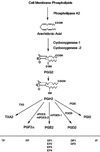Use of NSAIDs in treating patients with arthritis
- PMID: 24267197
- PMCID: PMC3891482
- DOI: 10.1186/ar4174
Use of NSAIDs in treating patients with arthritis
Abstract
Patients with rheumatic diseases, including rheumatoid arthritis and osteoarthritis, almost universally describe pain and stiffness as important contributors to reduced health-related quality of life. Of the treatment options available, NSAIDs are the most widely used agents for symptomatic treatment. NSAIDs are effective anti-inflammatory and analgesic drugs by virtue of their ability to inhibit biosynthesis of prostaglandins at the level of the cyclooxygenase enzyme. However, many of the adverse effects of NSAIDs are also related to inhibition of prostaglandin production, making their use problematic in some patient populations. For the clinician, understanding the biology of prostaglandin as it relates to gastrointestinal, renal, and cardiovascular physiology and the pharmacologic properties of specific NSAIDs is key to using these drugs safely. Of particular importance is the recognition of co-morbid conditions and concomitant drugs that may increase the risk of NSAIDs in particular patients. In patients with risk factors for NSAID toxicity, using the lowest dose of a drug with a short half-life only when it is needed is likely to be the safest treatment option. For those patients whose symptoms cannot be managed with intermittent treatment, using protective strategies is essential.
Figures

References
-
- Crofford L. In: Kelley's Textbook of Rheumatology. 9. Firestein GS, Budd RC, Gabriel SE, McInnes IB, O'Dell JR, editor. Philadelphia: Saunders; 2013. Prostanoid biology and its therapeutic targeting; pp. 871–893.
Publication types
MeSH terms
Substances
LinkOut - more resources
Full Text Sources
Other Literature Sources
Medical

